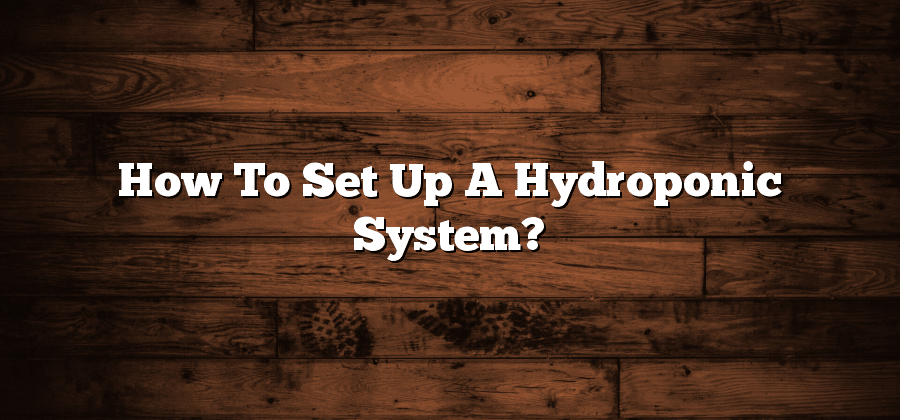Understanding the Basics of Hydroponic Systems
Hydroponic systems have gained popularity among gardeners and farmers due to their efficiency and ability to produce high-quality crops. Unlike traditional soil-based farming methods, hydroponics involves growing plants without soil, using mineral nutrient solutions in water. This method allows plants to receive the necessary nutrients directly, which leads to faster growth rates and increased crop yields.
One of the key components of a hydroponic system is the growing medium, which serves as a support system for the plants’ roots. Common types of growing mediums include coco coir, perlite, vermiculite, and clay pebbles. The choice of growing medium depends on factors such as the type of plant being grown, the system type, and water retention capabilities. In addition to the growing medium, a hydroponic system also requires adequate water supply, a nutrient reservoir, and a pump to circulate water.
Choosing the Right Location for Your Hydroponic System
Choosing the right location for your hydroponic system is crucial to its success. When it comes to finding the perfect spot, you want to consider a few key factors. Firstly, you need a space that receives ample natural light. Sunlight is the primary source of energy for plants, so you want to ensure they get enough of it. Look for areas in your home or greenhouse that have access to sunlight for at least 6-8 hours a day.
In addition to sunlight, you also need to consider the overall climate of the location. Extreme temperatures or constant fluctuations can negatively impact plant growth. Ideally, you want a space that maintains a consistent temperature range of around 65-80°F (18-27°C). This will create an optimal environment for your hydroponic system and allow your plants to thrive. Consider areas in your home or greenhouse that are easily regulated in terms of temperature and provide a stable climate for your plants.
Selecting the Appropriate Hydroponic System Type
One of the key considerations when setting up a hydroponic system is choosing the appropriate system type. With various options available, it is vital to understand the different types and their suitability for your specific needs. Each system offers its own advantages and disadvantages, so it is essential to evaluate them based on factors such as space availability, budget, and skill level.
One popular hydroponic system type is the Nutrient Film Technique (NFT). This system involves a shallow nutrient-filled channel where a thin film of nutrient solution flows over the plant roots. NFT systems are known for their water efficiency as they continuously recycle the nutrient solution, making them ideal for areas with limited water supply. However, it is important to note that NFT systems require a constant power supply to maintain the flow of the nutrient solution. Thus, they are more suitable for indoor setups or locations with reliable electricity access.
Gathering the Essential Equipment for Hydroponic Setup
When it comes to setting up your own hydroponic system, having the right equipment is essential for success. Gathering the essential equipment for your hydroponic setup can seem like a daunting task, but with a little planning and research, you can make sure you have everything you need to get started.
First and foremost, you will need containers to hold your plants and nutrient solution. These containers can come in a variety of shapes and sizes, depending on the type of hydroponic system you choose. It’s important to select containers that are durable and can withstand the weight of the plants as they grow. Additionally, you will need a good quality growing medium to support the roots of your plants. Some popular choices include perlite, vermiculite, and coco coir. Lastly, don’t forget about lighting. Since hydroponic systems are often set up indoors, you will need artificial lighting to provide your plants with the necessary light energy for photosynthesis. LED grow lights are a popular choice for their energy efficiency and ability to provide the right spectrum of light.
Preparing the Nutrient Solution for Your Hydroponic System
To ensure the success of your hydroponic system, it is crucial to prepare the nutrient solution properly. The nutrient solution provides the essential elements that plants need for their growth and development. Without a well-balanced and properly formulated solution, your plants may suffer from nutrient deficiencies or excesses, which can lead to stunted growth and decreased yields.
Before preparing the nutrient solution, it is essential to understand the nutrient requirements of the specific plants you are growing. Different plants have different nutrient needs, so it is crucial to tailor the solution accordingly. The three primary macronutrients that plants require are nitrogen (N), phosphorus (P), and potassium (K), often referred to as NPK. In addition to these macronutrients, plants also need various micronutrients such as iron, manganese, and zinc. To ensure that your plants receive all the necessary nutrients, you can either purchase a pre-formulated hydroponic nutrient solution or create your own by mixing individual nutrient salts.






